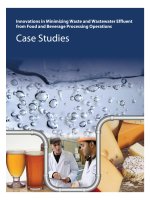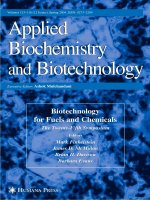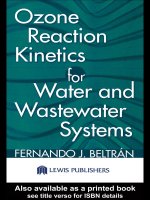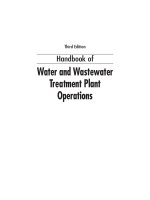Biotechnology for waste and wastewater treatment
Bạn đang xem bản rút gọn của tài liệu. Xem và tải ngay bản đầy đủ của tài liệu tại đây (10.4 MB, 245 trang )
BIOTECHNOLOGY
FOR
WASTE
AND WASTEWATER TREATMENT
by
Nicholas P. Cheremisinoff, Ph.D.
NOYES PUBLICATIONS
Weatwood,
New
Jerary,
U.8.A.
Copyright
0
1996
by Nicholas P. Cheremisinoff
No part
of
this book may be reproduced or utilized in
any form or by any means, electronic or mechanical,
including photocopying, recording or by any informa-
tion storage and retrieval system, without permission
in
writing from the Publisher.
Library of Congress Catalog Card Number:
Printed in the United States
ISBN:
0-8155-1409-3
Published in the United States of America by
Noyes Publications
Fairview Avenue, Westwood, New Jersey
07675
10
9 8 7 6 5 4
3
2
1
Library of Congress Cataloging-in-Publication Data
Cheremisinoff, Nicholas P.
Biotechnology for waste and wastewater treatment
/
Nicholas P.
Cheremisnoff.
p.
cm.
Includes bibliographical references and index.
1.
Sewage Purification Biological treatment.
2.
Water-
-Purification Biological treatment.
I.
Title.
TD755.C547 1996 96-45255
628.3 d~21
CIP
ISBN
0-8155-1409-3
PREFACE
This book examines the practices used or considered for
biological treatment of waterlwastewater and hazardous wastes.
The technologies described involve conventional treatment
processes, their variations, as well as recent research. The book
is
intended for those seeking an overview of the field, and covers
the major topics. The book
is
divided into five principal sections,
and references are provided for those who wish to dig deeper.
Nicholas
P.
Cheremisinoff
V
NOTICE
To
the best of our knowledge the information in this publication
is accurate; however, the Publisher does not assume any
responsibility or liability for the accuracy or completeness of, or
consequences arising from, such information. This book
is
intended for informational purposes only. Mention of trade names
or commercial products does not constitute endorsement or
recommendation for use by the Publisher. Final determination of
the suitability of any information or product for use contemplated
by any user, and the manner of that use, is the sole responsibility
of the user. We recommend that anyone intending to rely on any
recommendation of materials or procedures mentioned
in
this
publication should satisfy himself as to such suitability, and that
he can meet all applicable safety and health standards.
vi
ABOUT THE AUTHOR
Nicholas
P.
Cheremisinoff
is a private consultant to
industry, academia, and government. He has nearly twenty years
of industry and applied research experience in elastomers,
synthetic fuels, petrochemicals manufacturing, and environmental
control. A chemical engineer by trade, he has authored over
100
engineering textbooks and has contributed extensively to the
industrial press. He
is
currently working for the United States
Agency for International Development in Eastern Ukraine, where
he is managing the Industrial Waste Management Project. Dr.
Cheremisinoff received his
B.S.,
M.S., and Ph.D. degrees from
Clarkson College of Technology.
vii
CONTENTS
Prface
i
About
the Author
Y
CHAPTER
1
.
BIOTECHNOLOGY
FOR
INDUSTRIAL
AND
MUNICIPAL
WASTES
1
Wastewater Treatment
3
BOD
Removal
5
Types
of
Biological Processes
5
Municipal Wastewater
6
Activated Sludge Process
7
Sludge
10
Tapered Aeration
12
Step Feed Aeration
12
Contact Stabilization
12
Complete Mix
13
Extended Aeration
13
Oxidation Ditch
13
Anaerobic Digestion
15
SLUDGES
18
Desulfurization
21
Nitrification/Denitrification
25
Nitrification
27
Suspended Growth Systems
34
Attached Growth Systems
34
Aquatics
35
Concluding Remarks
35
Conventional (Plug Flow) Activated
MUNICIPAL TREATMENT PLANT
ix
v
vii
x
Contents
CHAPTER
2
.
BIOLOGICAL
DEGRADATION
OF
HAZARDOUS
WASTES
37
INTRODUCTION
38
ABIOTIC TREATMENT TECHNIQUES
42
Wastewater Treatment
42
Liquids-Solids Separation
42
Chemical Treatment
43
Physical Methods
44
Incineration
46
Wet Air Oxidation
48
Solidification Techniques
48
BIOLOGICAL CONTROL METHODS
49
Land Treatment
50
Composting
51
Liquids/Solids Treatment Systems (LSTS)
. .
52
Soil Biofilters
54
Wastewater Treatment
55
Activated Sludge Process
56
Trickling Over Process
56
Stabilization
57
DEGRADABILITY
57
Basis
for
Biodegradation
58
Genetics
59
Testing
for
Recalcitrance
61
Aerobic Tiered Testing
62
Anaerobic Tiered Testing
63
Testing
for
Recalcitrance
63
PILOT STUDIES
66
PCB Biodegradation
66
Methyl Ethyl Ketone
69
Landfill Leachate
70
DEGRADATION
71
TCE Degradation
71
Degradation
73
DETERMINATION
OF
BIOLOGICAL
LABORATORY STUDIES
OF
AEROBIC
Polycyclic Aromatic Hydrocarbon
Ring Fission Products
74
Phenanthrene Degradation
78
Contents
xi
Chlorophenol Degradation
79
Chlorinated Wastes
80
p-Nitrophenol Degradation
80
Degradation
of
Fluoro Substituted
Benzenes
81
Pentachlorophenol Degradation
81
Oil Degradation
82
HexachlorocyclohexaneDegradation
83
Metolachlor Degradation
87
Polyphosphate Degrading Enzymes
88
Aniline Degradation
85
Disulfide Removal
86
Activated Sludge Studies
87
Two Stage BiologicalKhemical Treatment
of
Leachate
89
ANAEROBIC BACTERIA
90
Metabolism
90
Anaerobic Processes
92
Perchloroethylene
93
Coal Gasification Wastewater
94
Tannery Wastes
94
1.1.
1.Trichloroethane Degradation In-Situ
. .
95
Patent
for
Haloaromatic Compounds
96
2.
4.Dichlorophenol
96
FUNGI
97
Dioxin
97
PAH Degradation
98
Selenium
99
Immobilization
of
Phenolics
99
Metalaxyl Degradation
99
CONCLUSIONS
100
REFERENCES
101
CHAPTER
3
.
BIOLOGICAL TREATMENT
OF
INDUSTRIAL
WASTES:
MUTANT
BACTERIA
111
BIOLOGICAL TREATMENT
.
OVERVIEW
111
MICROBIOLOGY BACKGROUND
112
xii
Contents
Energy and Carbon Sources
112
Type of Organisms
114
BACTERIAL GROWTH
116
Factors Affecting Growth
116
Temperature
116
pH
116
Oxygen
117
Nutrients
117
KINETICS
OF
GROWTH
117
Growth
Curve
117
Cultures
118
Substrate Utilization
119
Continuous Treatment
121
PROCESSES
122
Aerated Processes
123
Activated Sludge (Suspended Growth)
127
Aerated Lagoons
129
Waste Stabilization
132
Trickling Filter (Attached Growth)
132
Rotating Biological Contactors (RBC)
133
Packed
Beds
133
Landfarming
134
Anaerobic Digestion (Treatment)
135
MUTANT BACTERIA
137
Case Histories
138
Dissenting Opinions
144
REFERENCES
145
INDUSTRIAL WASTE TREATMENT
CHAPTER
4
.
NITRIFICATION
AND
DENITRIFICATION
IN
THE
ACTIVATED
SLUDGE
PROCESS
151
INTRODUCTION
151
FORMS OF NITROGEN
152
NITRIFYING BACTERIA
153
NITRIFICATION STOICHIOMETRY
155
NITRIFICATION PROCESS VARIABLES
AND KINETICS
156
Ammonium Oxidation
157
Contents
xiii
Nitrite Oxidation
158
Solids
Retention Time (SRT)
158
Effect
of
Temperature on Kinetics
159
Effect of
pH
on Kinetics
160
Effect of DO on Kinetics
160
Effect of Organic Loading on Kinetics
161
Inhibition
of
Nitrification
162
DENITRIFICATION
164
DENITRIFYING BACTERIA
164
DENITRIFICATION STOICHIOMETRY
165
DENITRIFICATION PROCESS VARIABLES
AND KINETICS
166
Kinetics
166
Effect
of
NO,.
N
Concentration on
Effect of Temperature on Kinetics
166
Effect of pH on Kinetics
167
Effect of Carbon Concentration on
Kinetics
167
NITRIFICATION PROCESSES
167
Plug-Flow Versus Complete Mix
167
Single-Stage Versus Two-Stage Systems
168
DENITRIFICATION PROCESSES
170
Denitrification Using Methanol as the
Carbon Source
170
Denitrification Using Organic Matter
Present in Raw Wastewater
174
Denitrification Using Thiosulfate and
Sulfide
176
SUMMARY AND CONCLUSIONS
177
REFERENCES
184
CHAPTER
5
.
IN-SITU BIORECLAMATION
OF
CONTAMINATED GROUNDWATER
189
INTRODUCTION
189
TREATING CONTAMINATED
GROUNDWATER
193
APPLICATION OF MODELING
196
SOC
and NO Profiles
196
One-BAZ Columr
198
xiv
Contents
TWO-BAZ
Column
199
Secondary Substrate Profiles
204
Carbon Tetrachloride
204
Bromoform. Ethylene Dibromide.
Tetrachloroethene. and Trichloroethene
. .
209
Simulation
of
Bioreclamation Strategies
210
CONCLUSIONS
216
REFERENCES
221
Index
225
1
BIOTECHNOLOGY
FOR
INDUSTRIAL
AND
MUNICIPAL WASTES
Hazardous waste management remains the primary area of concern for
many industries. Regulations, such
as
the Resource Conservation and
Recovery Act (RCRA), the Toxic Substance Control Act (TSCA), and
Superfund (CERCLA)
as
well
as
regulatory agencies, continue to keep
corporate attention and the pressure on.
An important area of technology is biological treatment, popularly
re-classified in recent years
as
Biotechnology.
Biotechnology has its
origins from an old science where we find applications in the antiquities.
It is however a new technology under-going
a
resurgence in a wide range
of applications, including past/present/future applications for the
pollution engineer.
Natural decomposition of inorganic and organic materials has
occurred for millions of years. Biological management of waste has been
practiced for thousands of years. Most microorganisms in use are
extracted from soil and water bodies and more recently technically
developed for specific applications, and uses organic and toxic materials
as
sources of energy and carbon. While in the future, biological
treatment will be based on microorganisms,
a
drastic departure from the
past will most likely take place based on the new science of recombinant
DNA.
The following are examples of recent research and applications of
wastes and toxics, using biotechnology control:
Some
20
different bacteria are said to be capable of breaking
down polychlorinated biphenyls into water and carbon
dioxide. One of these organisms from the genus Alcalie-
genes is photoactivated by sunlight. Sunlight enhances the
speed of degradation of
PCB
by some
400%.
1
Content
2
Biotechnology
for
Waste and Wastewater Treatment
Researchers, involved in training bacteria Bacillus
megaterium and Nocardiopsis to consume dioxin, observe
that dioxin could easily penetrate the cell walls and be
degraded faster if solvents such as ethyl acetate and dimethyl
sulfoxide were added to the broth.
A
strain of genetically engineered microorganisms degrades
95%
or more of the persistent 2,4,5-T within a week.
Microbes can also degrade a variety of dichlorobiphenyls and
chlorobenzoates.
Scientists have isolated a strain of Pseudomonas that uses
2,4-D
as a source of carbon.
The
gene involved was
isolated and inserted in a different host bacteria.
A
number of microorganisms containing plasmids bearing
genes for the degradation of aromatic molecules toluene and
xylene diverse salicylates and chloride derivatives of
4-
chlorocatecol have been tested.
Formulation of bacterial mutants are commercially available
for a variety of wastewater treatment problems. Specially
formulated preparations are used for petroleum
refinery/petroleum chemical plant wastewater cleanups. The
bacteria degrades various hydrocarbons and organic
chemicals (benzenes, phenols, cresols, napthalenes, amines,
alcohols, synthetic detergents, petroleum (crude and
processed)).
Grease eating bacteria having syccessfully been used in
cleaning clogged sewers.
A
major problem in recent decades has been the appearance
of new chemicals in the environment stretching the ability of
microorganisms to evolve by adaptation
of
existing catabolic
enzymes or by the appearance of new metabolic pathways,
the ability to degrade persistent xenobiotic compounds. We
are constantly learning from such organisms and selecting
those that show a maximum rate of biodegradation with
maximum substrate utilization and minimum microbial
biomass production.
Content
Biotechnology for Industrial and Municipal Wastes
3
Wastewater Treatment
Biological treatment is one of the most widely used removal methods as
well as for partial or complete stabilization of biologically degradable
substances in wastewaters and wastes. Suspended, colloidal or dissolved
degradable organic material, quantities and ratios depend on the nature
of the wastewater. Characteristics of wastewaters are measured in terms
of Chemical Oxygen Demand (COD), Biochemical Oxygen Demand
(BOD), and Volatile Suspended Solids
(VSS).
Most biological waste and wastewater treatment processes employ
bacteria
as
primary microorganisms; certain other microorganisms may
play an important role. Degradation of organic matter
is
effected by its
use as food by microorganisms to produce protoplasm for new cells
during the growth process. Population dynamics of bacteria in biological
treatment depends on environmental factors which include: pH;
temperature; type and concentration of the substrate; hydrogen acceptor;
essential nutrient concentration and availability; concentration of essential
nutrients (e.g.
,
nitrogen, phosphorous, sulfur, etc.); essential minerals;
osmotic pressure; media toxicity; byproducts; and degree of mixing.
Metabolic reactions occurring within a biological treatment process
can be divided into three phases:
Oxidation
Synthesis
Endogenous respiration
Oxidation-reduction proceeds either in the presence of free oxygen
(aerobically), or in its absence (anaerobically). Overall reactions may be
different under aerobidanaerobic conditions; microbial growth and
energy utilization are similar. The three phases are:
Organic
matter oxidation (respiration)
CP,O,
+
0,
+
CO,
+
H,O
+
energy
Content
4
Biotechnology
for
Waste and Wastewater Treatment
Cell material synthesis
CGHGO3
+
NH3
+
02
-+
CSH7NOz
+
CO2
+
H2O
Cell material oxidation
C5H7N02
+
NH3
+
5C0,
+
2H,O
+
energy
Various conventional methods that are used in biological treatment are
listed in Table
1
along with
the
treatment agents and typical wastes that
are treated.
TABLE
1
METHODS
OF
BIOLOGICAL TREATMENT
Process
Treatment Agent
(s)
Wastes Treated
Trickling filters Packed bed (stones or Acetaldehyde,
synthetic) covered by benzene, chlorinated
microbial film hydrocarbons, nylon,
rocket fuel
Activated sludge Aerobic microorganisms Refinery,
suspended
in
wastewater petrochemical and
biodegradable organic
wastewaters
Aerated lagoon Surface impoundment Biodegradable organic
plus mechanical aeration chemicals
Waste stabilization Shallow surface Biodegradable organic
ponds impoundments plus chemicals
aeration to promote
growth of algae and
bacterial and algal
symbiosis
Content
Biotechnology
for
Industrial
and
Municipal Wastes
5
BOD
Removal
In wastewater treatment microorganisms are not present
as
isolated cells,
but
as
a collection of microorganisms (such
as
bacteria, yeast, molds,
protozoa, rotifers, worms and insect larvae) in a mass. These
microorganisms tend to collect
as
a biological floc called biomass and
generally possess good settling characteristics. Biological oxida-
tiodstabilization of organic matter proceeds
as
follows:
High rate of BOD removal from wastewater upon contact
with active biomass. This removal and its extent depends on
loading rate, waste type, and biomass.
BOD is utilized in proportion to cell growth. Materials that
concentrate on the biomass surface are decomposed by
enzymes of living cells; new cells
are
synthesized;
decomposition end products are washed into the water or
escape into the atmosphere.
Biological cell material oxidizes through endogenous
respiration when food supply becomes limited.
Biomass is converted to settleable material or removable
solids.
Rates of these reactions depend on substrate transport rates,
nutrients, and oxygen (in case
of
aerobic treatment). Any one or more
of these transport rates can be the controlling factors that determine the
process efficiency.
Types
of
Biological Processes
Biological treatment processes can be divided into three groups:
0
Aerobic stationary contact systems-irrigation beds,
irrigation sand filters, and trickling biomass remains
stationary in contact with the solid support media (sand or
rocks) and the wastewater
flows
around it.
0
Aerobic suspended contact systems the activated sludge
process, its variations and aerobic lagoons comprise this
group. In this group both biomass and substrate are
in
suspension or motion.
Content
6
Biotechnology for Waste and Wastewater Treatment
Anaerobic suspended contact systems anaerobic sludge
digestion, anaerobic lagoons, and latter stages of landfills fall
in this category.
Municipal Wastewater
Sewage is about
99.95%
water and
0.05%
waste. It is the spent water
supply
of
a community. Due to infiltration of groundwater into loose
sewer pipe joints, the quantity
of
wastewater is often greater than the
water quantity that is initially consumed. More dilute sewage is a result
of greater per capita water consumption, and industrial and commercial
wastes contribute to sewage strength. Per capita sewage production can
vary from less than 100 gallons per day for strictfy residential areas to
300
gallons per day or more for industrialized areas.
A
typical sewage
composition may be:
Total solids
600
mgll Mineral
20
mgll
Suspended solids
200
mgll Filterable solids
400
mgll
Settleable solids 120
mgll BOD
(5
day 20%)
54
g1cap.lday
Colloidal solids
80
mgll Suspended
42
g1cap.lday
Organics
60
mgll Dissolved 12 g1cap.lday
The above estimate indicates a measure of the loading on a treatment
plant (this may be additionally complicated by the presence of industrial
effluents). The two principal processes utilized for biological (secon-
dary) treatment are the trickling filter and activated sludge process.
Objectives in waste management change. Originally sewage
treatment facilities were built primarily from a public health viewpoint
but now include objectives such
as
oxygen protection for receiving
waters. Clean water demand has increased more rapidly than population.
This
has
given rise to the supply of complete treatment plants for small
communities, developments, and isolated installations by manufacturers
of waste treatment equipment in the form of packaged plants. A
conventional scheme for wastewater treatment is illustrated in Figure
1.
The pretreatment stage often consists of separating out coarse materials,
grit, and oils. Primary treatment is comprised of the operations of
flotation and sedimentation. Secondary treatment can be a combination
of
an
activated sludge process, trickling filters, anaerobic or aerated
Content
Biotechnology for Industrial and Municipal Wastes
7
RiW
SECONDARY
TERTIARY
FINAL
-
EFFLUENT
WASCFXATER
/
I
AND
GRIT
1
4.
AERATED LAGOONS
REMOVAL
2.
OIL
SEPA-
RATION
I
5.
STABILIZATION
PONDS
I
''
s~~~~~N-
2.
TRICKLING
FILTERS
1
3.
ANAEROBIC
LAGOONS
I
I
I
I
Figure
1.
Typical wastewater treatment sequence.
lagoons, and stabilization ponds. This is often followed by sedimentation
and then tertiary treatment, which is sometimes called "polishing.
'I
Activated Sludge
Process
The activated sludge process is a widely used and effective treatment for
the removal of dissolved and colloidal biodegradable organics. It is
a
treatment technique well suited where organically contaminated
wastewater exists. The activated sludge process is used by a wide range
of municipalities and industries that treat wastewater containing organic
chemicals, petroleum refining wastes, textile wastes, and municipal
sewage.
The active sludge process converts dissolved and colloidal organic
contaminants into a biological sludge which can be removed by settling.
The treatment method is generally considered to be
a
form of secondary
treatment and normally follows a primary settling basin. The flow
diagram for
a
typical activated sludge treatment process is illustrated in
Figure
2.
There are several variations to this process including
conventional arrangements, the contact stabilization process, and the step
aeration process. Examples of these are given in Figure
3.
Content
8
Biotechnology
for
Waste and Wastewater Treatment
Content
Content
Biotechnology for Industrial and Municipal Wastes
9
-
-
EYZb%
-
RAW
WASTE
WATER
SLUDGE
TANK
RECIRCULATING
Co::iF
SLUDGE
AERATION TANK
FINAL
EXCESS
SLUDGE
-
CONVENTIONAL PLANT
EFFLUENT
RAW
WASTE
WATER
SLUDGE
f
RAW
WASTE
WATER
RAW
WASTE
WATER
SLUDGE
I
STEP AERATION PLANT
Figure
3.
Variations
of
the
activated sludge process.
In
the
activated sludge process the incoming wastewater is mixed and
aerated with existing biological sludge (microorganisms). Organics in
the wastewater come into contact with the microorganisms and are
utilized as food and oxidized to
CO,
and
H,O.
As
the microorganisms
use the organics as food they reproduce, grow, and die.
As
the
Content
10
Biotechnology for Waste and Wastewater Treatment
microorganisms grow and are mixed together by the agitation of air,
individual organisms floc together to form an active mass of microbes
called activated sludge. The wastewater flows continuously into an
aeration tank where air is injected to mix the activated sludge with the
wastewater and to supply oxygen needed for microbes to breakdown the
organic materials. This mixture of activated sludge and wastewater in
the aeration tank is called mixed liquor. The mixed liquor flows from
the aeration basin to maintain sufficient microbial population levels. This
is the return activated sludge, The excess sludge which constitutes waste
activated sludge is sent to sludge handling disposal.
Air is introduced into the system by aerators which are located at the
bottom of
the
aeration basin, or by mechanical mixers (surface aerators).
In addition, some processes utilize pure oxygen instead of air, known as
pure oxygen activated sludge.
The microorganisms in activated sludge generally are composed of
70
to
90%
organic and
10
to
30%
inorganic matter. The
microorganisms generally found in activated sludge consist of bacteria,
fungi, protozoa, and rotifers. The growth and predominance of
microorganism types are controlled by $a number of circumstances
including type of waste-organic matter (food), metabolic rate, and size.
Predominance of certain microorganisms can be an indicator of treatment
efficiency. Table
2
lists some of the microbes involved with the
degradation of organic pollutants. There are variations to the
conventional activated sludge process which are designed to overcome
disadvantages inherent in specific applications. Some
of
these are
described below.
Conventional (Plug
Flow)
Activated Sludge
The conventional activated sludge system is run in a plug flow pattern.
That is, both the untreated wastewater and the return sludge are
introduced at the head end of the aeration tank and mixed liquor is
withdrawn at the opposite end.
In
an ideal plug flow system
the
flow
will pass through the aeration tank without much mixing in the direction
of
flow. However, due to
the
aeration tank being aerated, mixing cannot
be avoided. The best means of approaching plug flow conditions
is
to
compartmentalize the chamber into a series of completely mixed reactors.
A
series of three or more reactors or compartments creates a truer plug
flow design.
Content
Biotechnology
for
Industrial and Municipal Wastes
11
TABLE
2
MICROBIAL DEGRADATION
OF
VARIOUS
ORGANIC
POLLUTANTS
Pollutant
Microbes
Involved
Petroleum hydrocarbons
Pesticidesherbicides
cyclodiene type (e.g.,
aldrin, dieldrin) organo-
phosphorus type (e.g.,
parathion, malathion)
2,4-D
DDT
Kepone
Piperonylic acid
Other chemicals:
Bis (2ethylhexyl)phthalate
Dimethylnitrosamine
Ethylbenzene
Pentachlorophenol
Lignocellulosic wastes:
Municipal sewage
Pulp mill lignins
(various phenols)
200
+
species
of
bacteria, yeasts, and
fungi; e.g., Acinetobacter,
Arthrobacter, Mycobacteria,
Actinomycetes, and Pseudomonas
among bacteria; Cladosporium and
Scolecobasidium among yeasts
Zylerion xylestrix (fungus)
Pseudomonas, Arthrobacter
Penicillium (fungus)
Pseudomonas
Pseudomonas
Serratia marascens (bacteria)
Photosynthetic bacteria
Nocardia tartaricans (bacteria)
Pseudomonas
Pseudomonas
Thermonospora (a thermophilic
bacterium)
Yeasts:
Aspergillus
Trichosporon
Bacteria: Arthrobacter
Chromobacter
Pseudomonas
Xanthomonas
Content









